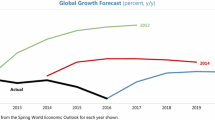Abstract
Given that the develo** countries today present a highly differentiated picture, is it appropriate to continue to speak of a “Third World”? If so, how does this group of countries appear to the present-day observer? What is their position within the world economy? What problems and challenges are they facing?
Similar content being viewed by others
References
Cf. A. J. Halbach: Industrieländer und Entwicklungsländer: Wächst die Kluft?, in: ifo-Schnelldienst, Vol. 44 (1991), pp. 3 ff. (esp. p. 3).
Cf. P. Nunnenkamp: Was wird aus der dritten Welt? Weltwirtschaftliche Herausforderungen und entwicklungspolitische Zusammenarbeit, in: Die Weltwirtschaft, Tübingen 1991, pp. 180 ff.
Cf. A. J. Halbach, op. cit. Industrieländer und Entwicklungsländer: Wächst die Kluft?, in: ifo-Schnelldienst, Vol. 44 (1991), pp. 4 ff. The corresponding indicators for industrial countries are $12,000–$27,000; 3,000 calories per day; and 75 years or over. Cf. World Bank: World Development Report 1990: Poverty, Washington D.C., pp. 201 ff.
Cf. A. Borrmann: Die Entwicklungsländer im Polarisierungsprozeß des Welthandels, in: B. Fischer (ed.): Die Dritte Welt im Wandel der Weltwirtschaft, Hamburg 1992, pp. 35 ff. incl. Tables 1 & 2; A. O. Krueger: Global Trade Prospects for Develo** Countries, in: The World Economy, Vol. 15 (1992), pp. 457 ff.
Cf. M. H. Dunn and H. Körner: Comment on chapter 5 (S. Chishti: Third World multinationals and trade expansion among the countries of the South), in: K. H. Khan (ed.): Multinationals of the South: New Actors in the International Economy, London/Hamburg 1986, pp. 118 f.
Cf. T. Wall: Soviet Demise brings Africa New Challenges, in: Africa Recovery, April 1992, p. 15.
Cf. A. Borrmann, op. cit. Die Entwicklungsländer im Polarisierungsprozeß des Welthandels, in: B. Fischer (ed.): Die Dritte Welt im Wandel der Weltwirtschaft, Hamburg 1992, p. 39; K. W. Menck: Trends in Foreign Direct Investment, in: A. Borrmann and H.-U. Wolff (eds.): Industrialization in Develo** Countries, Hamburg 1991, pp. 392 ff.; cf. also United Nations: World Investment Report 1991, New York 1991.
Cf. M. Holthus: Auslandsverschuldung und Ressourcenzufluss, in: B. Fischer (ed.), op. cit. Die Dritte Welt im Wandel der Weltwirtschaft, Hamburg 1992, pp. 126 ff.
R. Shams: Indebtedness and the Industrial Performance of Develo** Countries, in: A. Borrmann and H.-U. Wolff (eds.), op. cit. Industrialization in Develo** Countries, Hamburg 1991, pp. 323 ff.
J. Clark and E. Kalter: Recent Innovations in Debt Restructuring, in: Finance & Development, Vol. 29 (1992), pp. 6 ff.
H. J. Petersen: Verschuldungslage der meisten Entwicklungsländer bleibt problematisch, in: DIW Wochenbericht, Vol. 58 (1991), pp. 695 ff.
Cf. K. S. Warwick: Saving and Investment in Develo** Countries, in: Finance & Development, Vol. 28 (1991), pp. 36 ff.
Cf. R. Shams, op. cit. Indebtedness and the Industrial Performance of Develo** Countries, in: A. Borrmann and H.-U. Wolff (eds.), Industrialization in Develo** Countries, Hamburg 1991, pp. 327 ff.
Cf. P. Nunnenkamp, op. cit. Was wird aus der dritten Welt? Weltwirtschaftliche Herausforderungen und entwicklungspolitische Zusammenarbeit, in: Die Weltwirtschaft, Tübingen 1991, pp. 183 ff., esp. pp. 187 f.
Stiftung Entwicklung und Frieden: Globale Trends 1991, Bonn/Düsseldorf 1991, p. 80.
H. Mertens: Das Bevölkerungsproblem als Indikator ungleichgewichtiger Entwicklung, in: D. Nohlen and F. Nuscheler (eds.): Handbuch der Dritten Welt, Vol. 1, 3rd ed., Bonn 1992, p. 180.
J. A. Hauser: Bevölkerungs- und Umweltprobleme in der Dritten Welt, Berne 1991, Vol. 1, p. 23.
H. Mertens, op. cit. Das Bevölkerungsproblem als Indikator ungleichgewichtiger Entwicklung, in: D. Nohlen and F. Nuscheler (eds.): Handbuch der Dritten Welt, Vol. 1, 3rd ed., Bonn 1992, pp. 188 f.
Cf. M. P. Todaro: Economic Development in the Third World, 4th ed., New York/London 1989, pp. 217 ff.
For a similar stance, cf. World Commission on Environment and Development: Our Common Future, Oxford 1987.
On the following, cf. A. Chevallier and V. Kessler: Economies en développement et défis démographiques, Paris 1989.
On this, cf. Stiftung Entwicklung und Frieden, op. cit. Globale Trends 1991, Bonn/Düsseldorf 1991, pp. 81 f.
World Bank, op. cit. World Development Report 1990: Poverty, Washington D.C., p. 36.
H. Körner: Nachhaltige Nahrungsmittelproduktion und Armutsbekämpfung, in: H. Sautter (ed.): Entwicklung und Umwelt, Berlin 1992, pp. 113 ff.
World Bank, op. cit. World Development Report 1990: Poverty, Washington D.C. pp. 48 ff.
This is the term used by P. Nunnenkamp. op. cit. Was wird aus der dritten Welt? Weltwirtschaftliche Herausforderungen und entwicklungspolitische Zusammenarbeit, in: Die Weltwirtschaft, Tübingen 1991, pp. 180 ff.
Cf., e.g., H. Elsenhans: Zur Theorie und Praxis bürokratischer Entwicklungsgesellschaften, in: H. Körner (ed.): Zur Analyse von Institutionen in Entwicklungsprozess und in der internationalen Zusammenarbeit, Berlin 1989, pp. 109 ff.
Cf. H. Körner: Modernizing Turkish Economy and Society-External and internal adjustment experiences from World Bank adjustment progrmamens. in: H. Körner and R. Shams (eds.): Institutional Aspects of Economic Integration of Turkey into the European Community, Hamburg 1990, pp. 237 ff.
Cf. H. Körner: Interne Ursachen der Verschuldungsproblematik. Interessen, Strukturdefizite und Politikversagen in Entwicklungsländern, in: W. Filc et al. (eds.): Herausforderungen der Wirtschaftspolitik, Essays in honour of Claus Köhler, Berlin 1988, pp. 247 ff.; S. Haggard and R. Kaufmann: The Politics of Stabilization and Structural Adjustment, in: J. D. Sachs (ed.): Develo** Country Debt and the World Economy, Chicago/London 1989, pp. 263 ff.
See D. Weiss: Volkswirtschaftliche Beratung und Politikdialog, in: H. Körner (ed.), op. cit. Zur Analyse von Institutionen in Entwicklungsprozess und in der internationalen Zusammenarbeit, Berlin 1989, pp. 53 ff.
R. N. Chakraborty: Der Nord-Süd-Konflik als Problem der Konsensfindung bei konfligierenden Zielen, in: Konjunkturpolitik, Vol. 37 (1991), p. 276.
Author information
Authors and Affiliations
Rights and permissions
About this article
Cite this article
Körner, H. The “Third World” in the 1990s. Intereconomics 29, 92–97 (1994). https://doi.org/10.1007/BF02928149
Issue Date:
DOI: https://doi.org/10.1007/BF02928149




